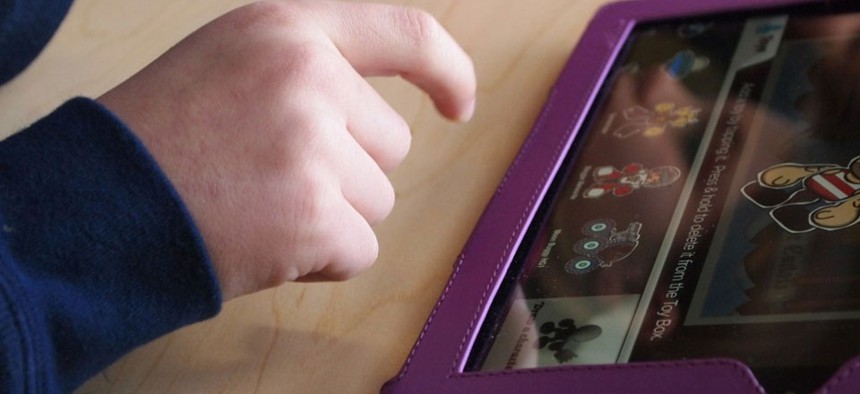How the FCC Could Revolutionize Education and Put Computers in More Students' Hands

An elementary student used an iPad in a school. Flickr user lickingerbrad
Restructuring the "E-rate" could vastly expand Internet access and give classrooms more digital tools.
Few, if any, of the confrontations captivating Washington this summer will affect daily life in America more than a subdued regulatory process that will begin Friday in an office building far from the capital's downtown power centers.
On Friday, the Federal Communications Commission will start restructuring the "E-rate" under which Washington provides funds to help schools connect to the Internet. This seemingly obscure decision could trigger an education revolution by enormously accelerating the deployment of tablets and other digital tools into classrooms. Even lawyers' eyes may glaze over when confronted with the gray columns in the "Notice of Proposed Rulemaking" the commission will unveil on Friday, but the document will provoke a kaleidoscope of change for the families of America's 76 million primary and secondary students—and sooner than many might imagine. "This is a once-in-a-generation opportunity to allow our education system to essentially leapfrog some of our competitor nations," says James Shelton, the acting Education Department deputy secretary.
The generational opportunity that Shelton and other advocates envision centers on the use of digital technology to create a more personalized learning environment. Reformers project a reimagined classroom in which all students are equipped with tablets or laptops that allow them to work at their own pace on lessons that adjust to their progress; use video links to take courses, such as advanced science lessons, only available at other schools; and receive real-time feedback from teachers who obtain reports on their performance through online connections with the students' devices. Constant digital updates would replace bulky out-of-date textbooks lugged in spine-crushing backpacks.
In June, the bipartisan Leading Education by Advancing Digital (LEAD) commission urged a national drive to provide digital devices to all students by 2020. Around that time, Los Angeles Superintendent John Deasy won approval for a $30 million contract to provide every student in the nation's second-largest school system with an Apple iPad. "Students are going to experience a common core [curriculum] with high standards in a very customized setting," Deasy declared at this month's Aspen Ideas Festival (cosponsored by National Journal's sister publication The Atlantic). New York City's two leading Democratic mayoral candidates are proposing a similar program.
These changes won't be possible unless schools upgrade their connections. Almost all U.S. schools are now online in some fashion. That's largely because of federal assistance provided by the E-rate, which was established under the 1996 Telecommunications Act passed by a Republican Congress and signed by President Clinton. Under the E-rate, consumers pay a monthly fee of about 30 cents per phone line to subsidize Internet connections for primary and secondary schools, which must also contribute to the cost.
While that program has provided most schools with basic connectivity, only about 20 percent of American students have access to "true high-speed Internet in their classroom," as President Obama noted last month. Speaking at a North Carolina middle school that has upgraded, he urged the FCC to develop a plan to provide 99 percent of America's students with high-speed connectivity within five years. "We are talking about moving from a school where the connectivity is one computer in the library to one where every kid has a device in their hands that allows them to manipulate a 3-D science project," says Cecilia Munoz, the White House domestic policy adviser.
The LEAD commission projects that meeting Obama's call for broadband in every classroom—which prompted the FCC rule-making—will cost between $6 billion and $9 billion. The White House estimates that to meet that cost consumers would face a temporary increase of about 35 cents in their monthly E-rate fee, less if the FCC can find savings from the existing program, as it will propose in Friday's notice.
Even with more money, this ambitious vision faces many hurdles. Administration officials acknowledge that the upgrade won't be affordable unless schools negotiate more effectively with telecommunications providers (some of which have faced persistent charges of failing to provide the E-rate's mandated discounts) and device manufacturers (which have not yet provided educators with mass low-cost options.) Software companies must develop more-sophisticated digital content, and teachers will need training to get the most from the new tools. Schools will need to teach "digital literacy and digital citizenship, and not just plunk a kid in front of a computer screen for seven hours a day," says James Steyer, a member of the LEAD Commission and founder of Common Sense Media, a group that monitors media's impact on children.
But if the FCC brings mass broadband to the classroom by expanding the E-rate program, it will create a vast new market for everything connected to digital education. That will likely spur a virtuous cycle of invention and competition that generates new answers to all of these challenges from educators, parents, and private companies alike. To promote new digital breakthroughs, the FCC for years has mostly bet on a strategy of deregulation. But to propel schools into the Information Age, government intervention looks like the indispensable first step toward unlocking private innovation.






